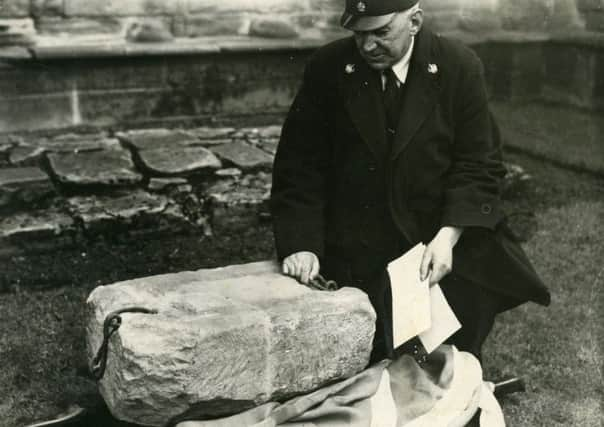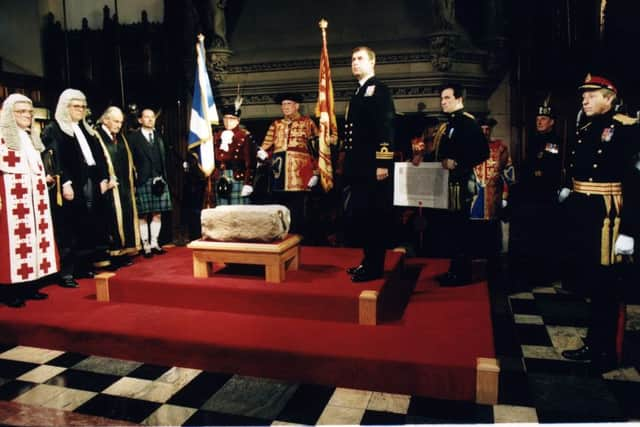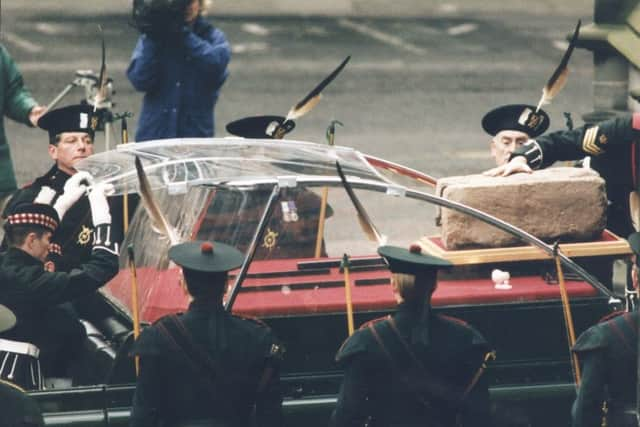On this day: Stone of Destiny returned to Westminster Abbey


To look at, the Stone of Destiny is an object remarkable only for its size, tipping the scales at a massive 152kg - more than 23 stone.
Used for centuries in the coronation of monarchs in Scotland, the artefact was historically kept at the now-ruined Scone Abbey in Scone, near Perth.
Advertisement
Hide AdAdvertisement
Hide AdThough no-one knows exactly where the stone originated from, many experts believe it arrived from the Middle East around 850 AD.


Legends and myths
Legend has it that the Stone of Destiny was used by Abraham’s grandson Jacob as a pillow in biblical times. According to others, it was used as a coronation stone by early Gaels in Ireland, and as a travelling altar by St Columba.
The stone’s Celtic name is Lia Fail, meaning ‘The Speaking Stone’, as it is said that the King of Dalraida, Kenneth I, was named by the stone itself.
Macbeth was the first Scottish monarch to be crowned atop the stone in the 11th century, with John Balliol the last King to use the stone on Scottish soil in 1292.


The Stone of Destiny was used during the coronation of current monarch, Queen Elizabeth II, in 1953.
Made of red sandstone, the object has several scratches along its surface from when it was removed from the Westminster Abbey coronation throne it resided under.
Westminster Abbey heist
In 1296, the stone was captured by Edward I as spoils of war and taken to Westminster Abbey.
Advertisement
Hide AdAdvertisement
Hide Ad

On 13 April 1951, the Stone of Destiny was returned to Westminster Abbey in London after a daring heist.
It had been stolen on Christmas Eve the previous year by a group of Scottish students, who had hidden it under a saltire at Arbroath Abbey in Scotland until it was returned following a large public outcry.
The group of students - Ian Hamilton, Alan Stuart, Kay Mathieson and Gavin Vernon - actually managed to damage the stone by dropping it in transit, before secretly repairing it ahead of its temporary relocation to Arbroath.
But while the stone was eventually returned, rumours have abounded as to whether or not the stone that was returned is the original, highly-valued symbol of Scottish history.


Complicating matters further is the existence of a police folder full of papers relating to the theft of the stone in 1950.
Conspiracy?
Currently held by the University of Glasgow’s Archive Services, the papers indicate that “numerous misleading trails [of evidence]” were placed, and conspiracy theories of “duplicate stones abound”.
The papers were gifted to then-University of Glasgow chancellor Sir William Kerr Fraser by the detective inspector of police in charge of the case in Scotland. Amongst the collection are police notes is a file of surveillance photographs.
Advertisement
Hide AdAdvertisement
Hide AdWriting in Dunaskin News, the University of Glasgow’s Archive Services online newsletter, contributor Natalie Milne said: “The inventiveness of the culprits and their accomplices is apparent in the papers. No light is shed on whether the stone currently on display in Edinburgh is truly the one stolen from Westminster.”
Shortly after the return of the stone, the Home Secretary issued a statement outlining that it was “not in the public interest” to pursue prosecution against the Glasgow University students who had taken it in the first place.
Back home to Scotland
On St Andrews Day 1996, the Stone of Destiny was legally returned to Scotland with a ceremony and celebration befitting its status. Since that day, it has remained within the confines of Edinburgh Castle alongside the Honours of Scotland.
The ceremony was well-attended, with approximately 10,000 people lining the Royal Mile to see the stone escorted from the Palace of Holyrood House to the castle.
Great Britain reserves the right to reclaim the stone at any time in the future, should it be needed for another coronation.
In 2008,the then-First Minister Alex Salmond claimed that the Stone of Destiny is a medieval fake, thus reigniting the debate in the modern era.
Visitors to Scone Palace today can also see a replica of the stone that resided there centuries before.